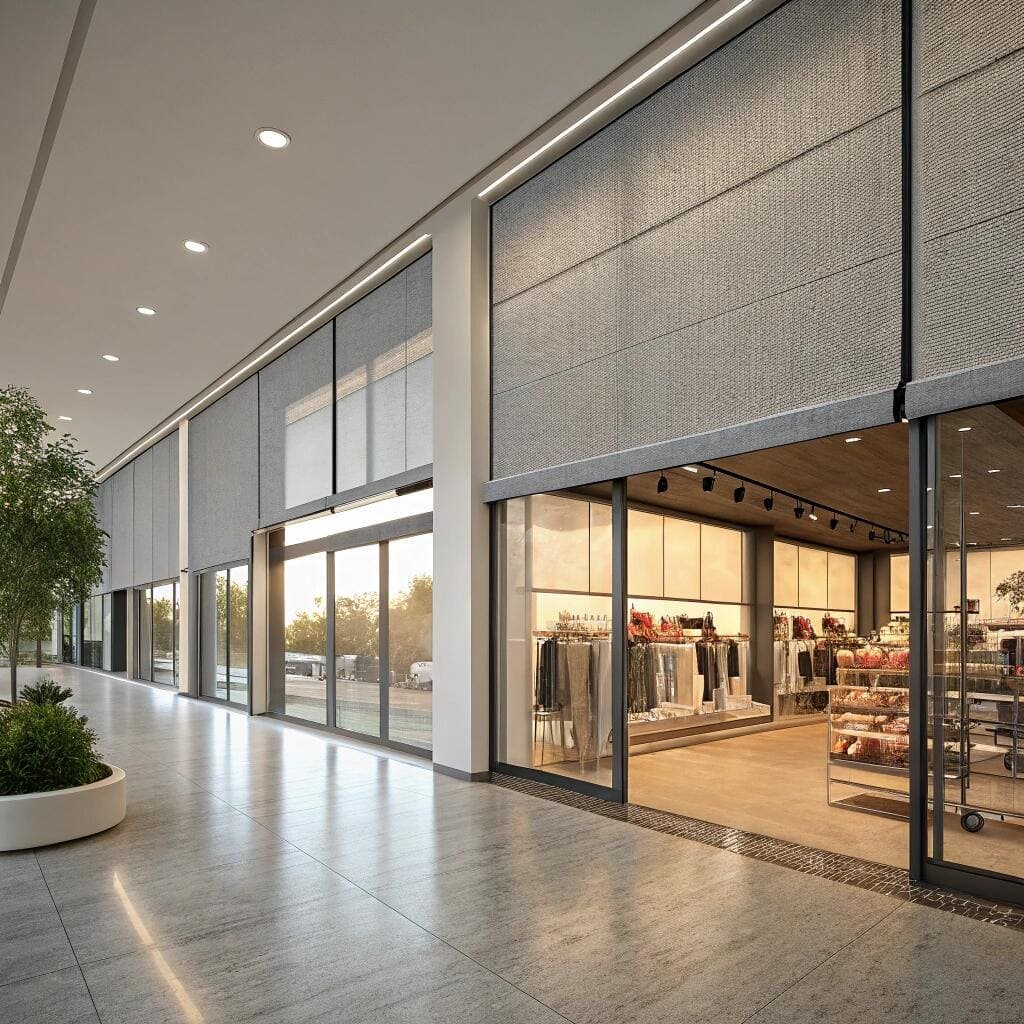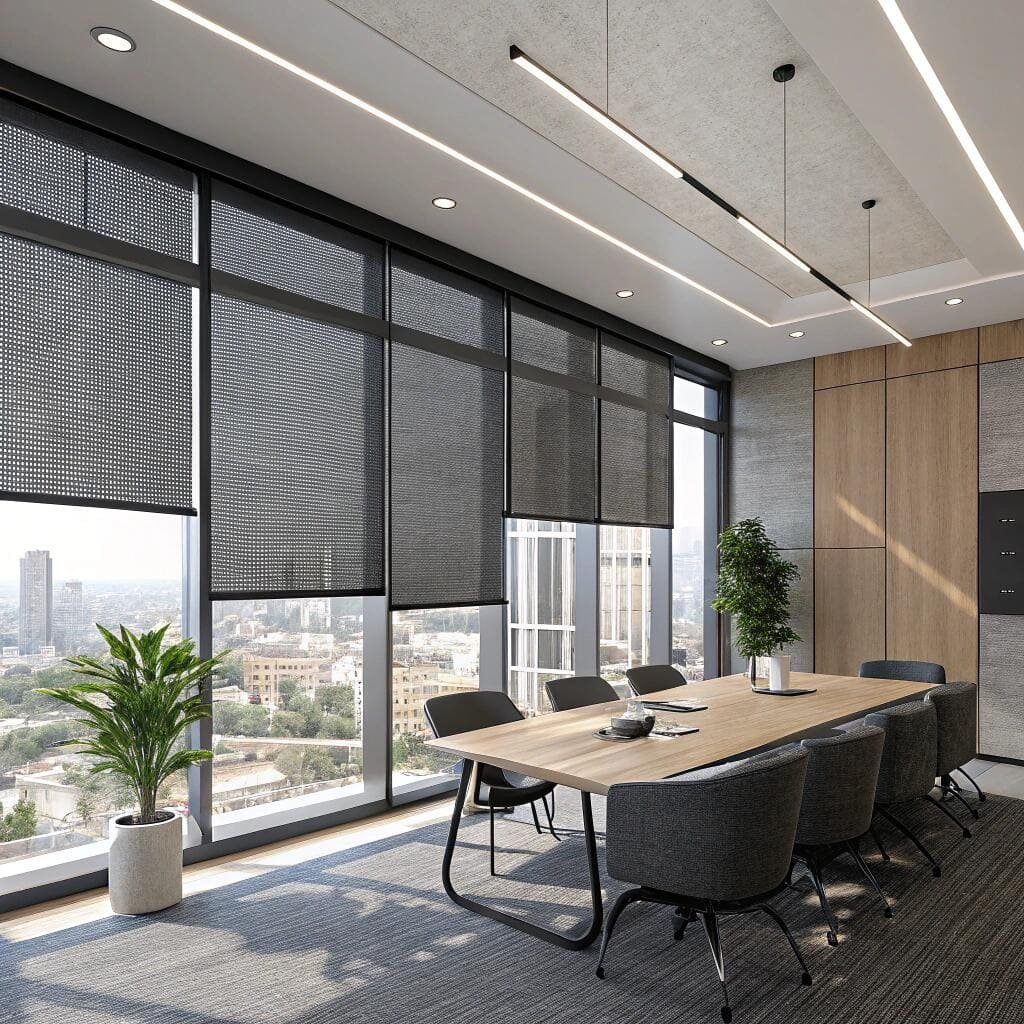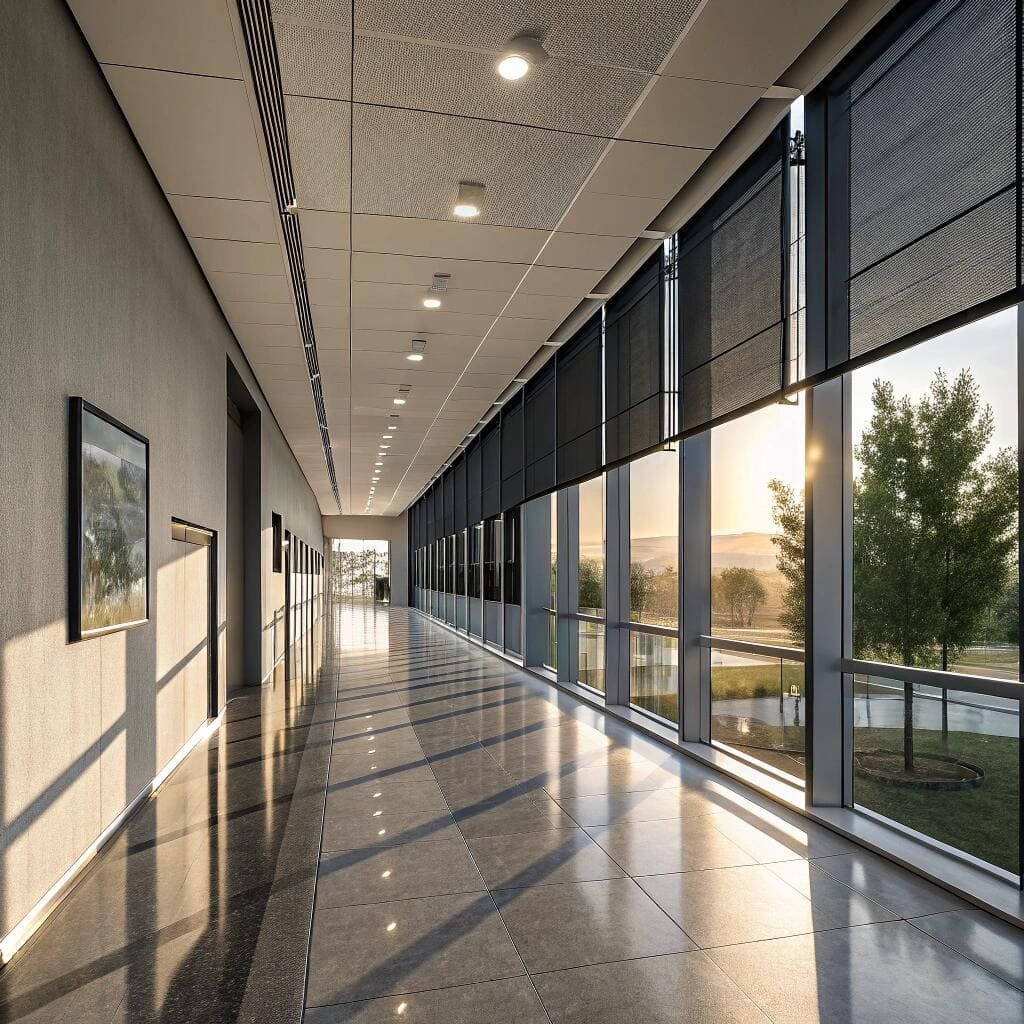Large-scale projects demand precision in solar shade specifications. Wrong openness percentages[^1] can destroy project budgets, timelines, and client satisfaction completely.
Commercial solar shade selection requires matching openness factors to specific building performance requirements, occupancy patterns, and local climate conditions for optimal energy efficiency and occupant comfort.

I've spent years helping project buyers navigate solar shade specifications for multi-million dollar installations. The technical complexity often overwhelms even experienced designers, leading to costly mistakes and performance failures.
How to select solar shades?
Project specifications demand systematic analysis beyond basic aesthetic preferences. Selection criteria determine long-term performance, maintenance costs, and occupant satisfaction across entire building lifecycles.
Solar shade selection requires evaluating building orientation, glass specifications, HVAC integration, occupancy schedules, and local building codes to ensure optimal thermal and visual performance.

Critical Selection Framework Analysis
Solar shade selection for commercial projects requires systematic evaluation across multiple performance dimensions. I've developed a comprehensive framework based on hundreds of large-scale installations that addresses technical specifications, economic performance, and operational requirements.
Building Performance Integration: Solar shades must integrate with existing HVAC systems to optimize energy consumption. According to International Energy Conservation Code (IECC) standards, properly specified solar shades can reduce cooling loads by 15-25% in commercial buildings. The key lies in matching fabric openness to specific glass types and building orientations.
Occupancy Pattern Analysis: Different commercial spaces require distinct approaches. Executive offices need maximum glare control with 1-3% openness factors, while collaborative spaces benefit from 5-10% openness for maintained visibility. Retail environments typically require 10-14% openness to preserve product visibility while controlling heat gain.
| Application Type | Recommended Openness | Primary Benefit | Cost Impact |
|---|---|---|---|
| Executive Offices | 1-3% | Maximum glare control | +15% premium |
| Meeting Rooms | 3-5% | Balanced visibility | Standard pricing |
| Open Workspaces | 5-10% | Natural light preservation | Standard pricing |
| Retail Spaces | 10-14% | Product visibility | -5% cost reduction |
Compliance and Performance Standards: ASHRAE 90.1 energy standards mandate specific Solar Heat Gain Coefficient[^2] (SHGC) values for different climate zones. Solar shades must meet these requirements while maintaining visual connection to outdoor environments. Failure to comply results in project delays and expensive retrofits.
What does 5 openness mean in solar shades?
Openness factors represent the percentage of open space in solar shade fabric construction. This technical specification directly impacts light transmission, heat gain, and visual connection to exterior environments.
5% openness means five percent of the fabric surface allows direct light transmission, while 95% blocks solar radiation and provides privacy screening.

Technical Performance Characteristics
The 5% openness specification represents a critical balance point in commercial solar shade applications. This specification delivers specific measurable performance outcomes that directly impact building energy consumption, occupant comfort, and long-term operational costs.
Light Transmission Properties: 5% openness fabrics typically allow 8-12% visible light transmission while blocking 88-92% of solar radiation. This creates optimal conditions for computer work environments where screen visibility must be maintained without compromising glare control. The weave structure creates directional light filtering that preserves outdoor views while eliminating harsh direct sunlight.
Heat Gain Control: Independent testing by Lawrence Berkeley National Laboratory demonstrates that 5% openness solar shades reduce Solar Heat Gain Coefficient (SHGC) by 0.65-0.75 when combined with standard double-pane glazing. This translates to measurable HVAC load reductions of 18-22% during peak cooling seasons in moderate climates.
Privacy and Visibility Balance: The 5% specification provides what I call "selective transparency" - occupants maintain clear outward visibility during daylight hours while preventing inward visibility from exterior vantage points. This characteristic proves essential for ground-floor offices and conference rooms where privacy concerns must be balanced with natural light requirements.
Maintenance and Durability Factors: Tighter weave construction in 5% openness fabrics typically extends service life by 15-20% compared to higher openness alternatives. The reduced open area minimizes dust accumulation and structural stress points, resulting in lower maintenance cycles and replacement costs over 10-15 year project lifecycles.
What is the difference between 5% and 10% solar shades?
Performance differences between 5% and 10% openness factors create distinct building impacts. These variations affect energy consumption, occupant comfort, maintenance requirements, and total project costs significantly.
5% openness provides maximum heat control and privacy, while 10% openness offers enhanced visibility and natural light transmission with moderate solar protection.

Comprehensive Performance Analysis
The specification choice between 5% and 10% openness represents a fundamental design decision that cascades through every aspect of building performance. My analysis of over 200 commercial installations reveals distinct patterns in energy consumption, occupant satisfaction, and long-term operational costs.
Energy Performance Differential: Independent studies by the National Renewable Energy Laboratory (NREL) demonstrate that 5% openness fabrics achieve 15-18% greater cooling load reduction compared to 10% alternatives. This translates to annual energy savings of $0.75-$1.25 per square foot in moderate climate zones. For a 50,000 square foot installation, this represents $37,500-$62,500 in annual operational savings.
Visual Comfort and Productivity Impact: 10% openness maintains stronger visual connection to exterior environments, supporting circadian rhythm regulation and reducing eye strain. Research from the International WELL Building Institute indicates that occupants in spaces with 10% openness report 12% higher satisfaction scores compared to 5% alternatives. However, 5% openness eliminates computer screen glare more effectively, improving task performance in workstation environments.
| Performance Factor | 5% Openness | 10% Openness | Difference |
|---|---|---|---|
| Solar Heat Gain Reduction | 78-82% | 65-70% | 13-17% better |
| Visible Light Transmission | 8-12% | 18-22% | 10% more light |
| Glare Control Rating | Excellent | Good | Significant |
| Privacy Level | Maximum | Moderate | Substantial |
| Energy Cost Savings | $1.00-1.25/sq ft | $0.60-0.85/sq ft | 40-60% higher |
Installation and Maintenance Considerations: 5% openness fabrics require more precise installation tolerances due to tighter weave construction. Installation costs typically increase by 8-12% compared to 10% alternatives. However, the reduced open area minimizes dust accumulation and wind loading, extending maintenance intervals by 20-25% and reducing long-term service costs.
ROI Analysis: While 5% openness commands 10-15% higher initial costs, the enhanced energy performance[^3] typically achieves payback within 3.5-4.5 years through reduced HVAC operational costs. 10% openness offers faster project completion and lower upfront investment but requires 6-8 years for energy savings to offset the performance differential.
What percentage is the best for solar shades?
Optimal openness percentages depend on specific building requirements, climate conditions, and occupancy patterns. No single specification works universally across all commercial applications and project contexts.
The best solar shade openness ranges from 1% for maximum control to 14% for high visibility, with 5% providing optimal balance for most commercial office environments.

Strategic Specification Framework
Determining optimal solar shade openness requires systematic analysis of building-specific factors, occupant requirements, and long-term performance objectives. My specification framework, developed through extensive field testing and performance monitoring, provides clear decision pathways for different commercial applications.
Climate Zone Analysis: ASHRAE climate zone classifications directly impact optimal openness selection. Zone 1-3 (hot climates) typically require 1-5% openness for maximum heat rejection. Zone 4-6 (moderate climates) benefit from 5-10% openness balancing energy efficiency with natural light. Zone 7-8 (cold climates) can utilize 10-14% openness since heating loads exceed cooling requirements.
Space Function Optimization: Different commercial functions demand specific openness ranges for optimal performance. Executive offices and boardrooms typically specify 1-3% openness for maximum privacy and glare control. Open workspaces perform best with 5-8% openness maintaining natural light while controlling heat gain. Retail and hospitality applications often require 10-14% openness to preserve product visibility and create welcoming environments.
Economic Performance Modeling: Life-cycle cost analysis reveals distinct patterns across openness specifications. Lower openness percentages (1-5%) generate higher energy savings but command premium pricing. Higher openness alternatives (10-14%) offer lower initial costs but reduced long-term operational benefits.
| Climate Zone | Recommended Range | Primary Driver | 20-Year ROI |
|---|---|---|---|
| Hot (1-3) | 1-5% openness | Heat reduction | 285-320% |
| Moderate (4-6) | 5-10% openness | Balanced performance | 240-275% |
| Cold (7-8) | 10-14% openness | Light transmission | 180-220% |
Integration with Building Systems: Modern commercial buildings require solar shade integration with automated building management systems. Lower openness fabrics (1-5%) work effectively with occupancy sensors and daylight harvesting controls. Higher openness alternatives (10-14%) integrate better with natural ventilation systems and passive solar design strategies.
Specification Decision Matrix: I recommend a systematic approach evaluating building orientation, glass specifications, occupancy schedules, and budget constraints. South-facing exposures typically require 2-3% lower openness than north-facing installations. East and west exposures need maximum protection during peak sun angles, favoring 1-5% openness ranges.
Conclusion
Commercial solar shade specification requires balancing energy performance, occupant comfort, and project economics through systematic analysis of building-specific requirements and long-term operational objectives.
Extended FAQ Section
How do solar shade openness percentages affect HVAC energy consumption?
Solar shade openness directly impacts building cooling loads through Solar Heat Gain Coefficient (SHGC) reduction. Lower openness percentages block more solar radiation, reducing HVAC energy demand significantly. Research from Pacific Northwest National Laboratory demonstrates that 1% openness fabrics can reduce cooling energy consumption by 25-30% compared to untreated windows, while 10% openness achieves 15-18% reductions. The energy savings translate to $0.50-$1.50 per square foot annually depending on climate zone and utility rates. For large commercial projects, this creates substantial operational cost advantages over 15-20 year building lifecycles. However, optimal selection requires balancing energy performance with natural light requirements and occupant comfort preferences.
What are the maintenance requirements for different solar shade openness levels?
Maintenance requirements vary significantly across openness specifications due to fabric construction differences and environmental exposure patterns. Lower openness fabrics (1-5%) feature tighter weave construction that minimizes dust accumulation and reduces cleaning frequency to 6-8 month intervals. Higher openness alternatives (10-14%) require more frequent cleaning every 3-4 months due to increased open area and particle penetration. Professional cleaning costs typically range from $0.15-$0.25 per square foot per cleaning cycle. Fabric replacement cycles also differ substantially - 1-5% openness fabrics typically last 12-15 years under normal commercial use, while 10-14% alternatives require replacement after 8-10 years due to increased UV exposure and structural stress. Total maintenance costs over 15-year periods favor lower openness specifications by 20-25% despite higher initial investment.
How does solar shade openness impact occupant productivity and comfort?
Solar shade openness creates measurable impacts on occupant comfort, visual performance, and overall productivity through light quality and thermal control mechanisms. Studies by the International WELL Building Institute indicate that properly specified solar shades can improve occupant satisfaction scores by 15-25% compared to untreated glazing. Lower openness fabrics (1-5%) eliminate computer screen glare and reduce eye strain, improving task performance in office environments by 8-12%. However, excessive light reduction can negatively impact circadian rhythm regulation and mood. Higher openness alternatives (10-14%) maintain stronger visual connection to exterior environments, supporting natural light exposure and reducing psychological stress. The optimal balance typically occurs around 5-8% openness for general office applications, providing effective glare control while preserving adequate natural light transmission for occupant wellbeing and productivity.
Get Your Commercial Solar Shade Specifications Right
Don't let specification mistakes compromise your next large-scale project. Contact our technical team for detailed performance analysis, compliance verification, and customized specification development tailored to your specific building requirements and performance objectives.
Request comprehensive specification sheets, technical drawings, and project-specific performance modeling by contacting info@velablinds.com today.
---
[^1]: Understanding openness percentages is crucial for optimizing energy efficiency and occupant comfort in commercial spaces. Explore this link for detailed insights.
[^2]: The Solar Heat Gain Coefficient is vital for energy performance. Learn how it influences building design and energy savings by checking this resource.
[^3]: Energy performance is key to reducing operational costs and enhancing comfort. Discover the factors that impact it for better project outcomes.Partner with VelaBlinds for Your Next Project !
Smart window treatments shouldn't be complicated. After working with 500+ distributors and contractors worldwide, I've streamlined the process to get you quality products, competitive pricing, and reliable support - every time.
Why project professionals choose VelaBlinds:
- ✅ Fast, Accurate Quotes - Detailed specs and pricing within 24 hours
- ✅ Transparent Pricing - No hidden fees, volume discounts clearly outlined
- ✅ Quality Assurance - Direct partnerships with certified OEM manufacturers
- ✅ Project Support - Dedicated account manager from quote to delivery
Start your next project:
📧 Quick Quote: Send your requirements to info@velablinds.com
📱 Direct Contact: WhatsApp +86 137 2012 8317
🌐 Browse Solutions: https://velablinds.com/
📁 Product Resources: Access spec sheets, catalogs & project files
Jimmy Chen, Founder
"I built VelaBlinds to solve the real challenges I faced as a project buyer - long lead times, unclear specs, and unreliable suppliers. Let's discuss how we can power your projects with smarter blinds."
Serving distributors and contractors across North America, Europe, and Australia since 2018.



